Iran holiday guide: from Tehran to Isfahan and beyond | Travel
My beloved British friends! It has been 25 years since I threw that goodbye party in Brixton, complete with saffron-laden rice dishes, to bid you farewell before I returned to Iran. You were the cast of my life from the day I arrived as a homesick 12-year-old. From schoolgirl, to undergraduate, to Londoner, you were at my side.
Yet, in a quarter-century, none of you has accepted my offer of coming to visit me here. The image of Iran is so calcified by its politics that not even one of your own could persuade you to come and explore for yourself. This is my last-ditch invitation: maybe you’ll get over that psychological hurdle and catch the six-hour flight to Tehran.
You will need to organise a visa and travel through a tour operator though, since Britons can’t get a visa at the door, unlike many other nationalities. But that is easily done, so many Britons and Americans are visiting these days – and from Monday British Airways has daily flights to Tehran from London.
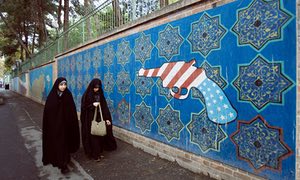
The capital. This is where you’ll get a chance to see, first-hand, the Iran you know from news bulletins. The wall murals often seen in stock media images are a great way to step into the recent history of the place. They lionise revolutionary leaders and, more poignantly, memorialise martyrs of the eight-year war with Iraq. Almost every street is named after someone lost in that war. The murals provide an insight into the country’s priorities: from the zeal of early revolution and war to the contemporary penchant for the decorative. The walls of the US embassy, now officially referred to as “the nest of spies”, will provide selfie backdrops to shake your Instagram feed.
Having explored the political veneer of the city, we’ll head to Golestan Palace in the heart of old Tehran. Here, Nassereddin Shah, the 19th-century Qajar king, introduced photography to Iran and practised his hobby taking pictures of the moustachioed women of his harem. The palace has an impressive archive of Iranian photography, thanks to him.
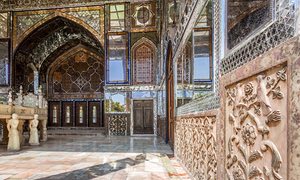
By now you’ll be hungry, so we’ll take a short walk to the entrance of the Grand Bazaar, the bustling hub of commercial activity. You can find almost anything here, but we are stopping for the famous lunch at “>Moslem restaurant. We’ll queue to get into this congested delight, but it’s worth it: it serves the best tah-chin in town. Portions of saffron and yogurt rice, served with chicken and barberries, easily feed two Iranians – and we know how to eat!
Moving on, we will go find Tehran’s buzzing art scene, where the young and the hip spend Friday afternoons gallery-hopping. New galleries around town are helping regenerate the old centre of Tehran: these include Aaran Gallery (12 Dey Street) which showcases work by young Iranian artists. As we head north, we’ll pop into Ag Gallery (3 Peysan Street) for photography, via Dastan’s Basement (6 Bidar Street) a bijou gallery where the art is still affordable.
Perhaps we’ll grab a Persian herbal infusion in one of the many new coffee shops, as the après art scene requires – you won’t see a Starbucks or McDonald’s while you’re here. Now, there’s an incentive.
Kashan
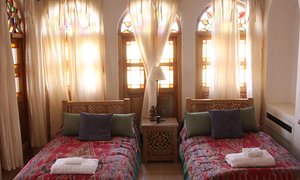
Many Iranians like to go north to take in the Caspian Sea’s lush vegetation and humid climate. But most foreign visitors go south to see the historic cities of Isfahan, Shiraz and Yazd. We’ll start in Kashan, the gateway city to the central desert region and will stay at Manouchehri House (doubles from £70), a 19th-century property, now a boutique hotel, renovated even as the country was experiencing the worst of the sanctions.
When many people were thinking of leaving, the owner raised this house from a heap of dust and rubble. We all thought she was crazy but, these days, booking in advance is necessary to enjoy a night in what is now an admired example of architectural renovation. Tehranis, tired of the crowds and the villas that have mushroomed in the Caspian region, now run to the desert to buy and rebuild abandoned homes.
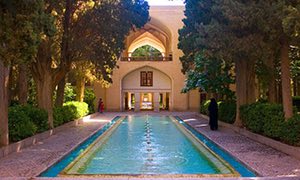
In Kashan we’ll also visit the Agha Bozorgi seminary, the only mosque in Iran with a sunken garden. Before we turn away from the city, we’ll visit Fin Garden too, which had the dubious honour of housing Amir Kabir, one of Iran’s modernising prime ministers in exile. He was killed in the bath house. To lighten the mood, we’ll grab a kebab, sitting on beds alfresco, at Gholam’s Kebab House before hitting the motorway towards Yazd.
On the way to Yazd
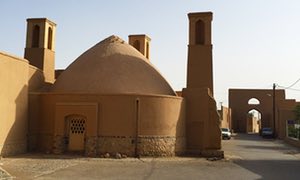
There can be stops at any town that takes your fancy as we travel along the edge of Dasht-e Kavir, one of Iran’s two central deserts. There are significant historical sites in Natanz, Naeen and Ardestan, the latter home to a mosque built on the remains of a Zoroastrian fire temple dating from 1158. There’s also the Moon Qanat, an ancient double-tier aqueduct. The underground irrigation system associated with it dates from 1,000BC, and is an early technological wonder that brought water to Persia’s many arid cities, employing a system of underground wells and canals.
It’s a long journey, so we’ll stop for the night at Aghda, famous for its pomegranates, where the old town has been abandoned in favour of modern housing. The mainly uninhabited neighbourhood makes for an evocative stroll. One of the larger houses has been restored as the cosy Khaloo Mirza hotel (doubles from £25). Here, we’ll sleep on floor mats in shared rooms, traditional Iranian style. Food is provided by the hotelier’s aunt from a large kitchen, and it will no doubt include Aghda’s superb pomegranate paste.
Camping in Dashte E Kavir
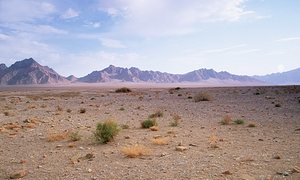
Before getting to Yazd, we’ll make a detour to join an off-road group to camp amid the desert dunes, where the landscape is spectacular and the unexpected flora otherworldly. This vast landscape is not a place to go on your own, so we’ll join Hamid Boreiri, who has been leading groups on desert excursions for 19 years (zistnc.com).
Everyone brings their own 4WD vehicle (spare seats are shared around). We’ll help dig the car out of soft sand as we traverse the dunes, and pitch camp ourselves – it’s tents and sleeping bags here. Travellers report that they feel a surge of energy under the desert skies. Walking barefoot in the sand exfoliates your feet but it also cleanses the soul. You certainly come out of the desert feeling lighter. Maybe it’s to do with the salt in the sand; these deserts were once seas. Maybe the feminine curves of the dunes suggest a softer place. That said, all that screaming as vehicles crest the dunes is cathartic!
Yazd
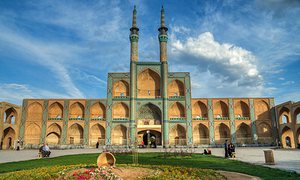
To Yazd, the city of wind towers, which suck the hot desert air down on to a shallow pool of water and cool the house. One of these has been recreated in a wonderland mall in Dubai but here, in Dowlatabad Garden, we can see the tallest functioning wind tower in the world. No other city in Iran has been preserved so meticulously by its residents, who have resisted the lure of building the classical pastiche high-rises so beloved of the nouveau riche in Tehran.
The city has strong associations with Iran’s pre-Islamic religion. Zoroastrians gather annually at Chak Chak, a mountainside temple closed to Muslims. But we can visit a functioning fire temple in town and make the hike to the Towers of Silence where, until 70 years ago, bodies of dead Zoroastrians were left to be consumed by carrion birds. Follow me to the Khalifa pastry shop and order its famed Yazdi delicacies of baghlava and sweetmeats to take back home.
Amir Chakhmagh, a three-storey structure known as a hosseinieh – for commemoration ceremonies – will bring us back to Iran’s present Shia rituals. This is a place where the martyrdom of Imam Hossein is marked each year. The large wooden nakhl, representing a palm that carried his body, is dressed in black decorative cloth and used as the centrepiece for the mourning processions of Ashura every year.
Rest will come at Khan restaurant, once a typical Iranian hammam, before we go to sample broad bean and dill rice with lamb at Talar Yazd restaurant. We’ll stay in Moshirolmamalek hotel (doubles from £115 B&B) with its own Persian garden on the edge of the city.
Shiraz
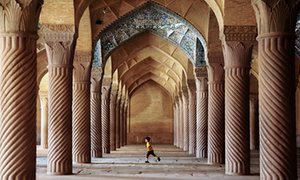
How can we not visit Shiraz, the garden of Iran and the heart of its poetic soul? Venerated poets Sa’di and Hafez are buried here. Iranians use Hafez’s mystic poetry for divinations, and visit his grave as if on a secular pilgrimage. Although we will have to dash to see all that is on offer here, dashing is not the Shirazi way. Whereas Isfahanis are famous for their quick wit and love of money, Shirazis are known for their appreciation of a gentler lifestyle centred on the city’s many private and public gardens. The city has a fine selection of accessible Persian gardens, including Eram, Jahan-nama, and Delgosha, and the newly reopened Shapouri Pavilion Garden includes a new restaurant where we can take the weight off our feet.
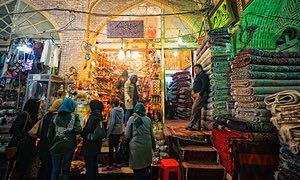
The city’s sublime air, laced with the scent of orange blossom wafting from the many citrus orchards, is legendary. The Shirazi aromatic lime is indispensable to our cooking, and is served liberally with faloodeh, the local frozen noodle dessert. The Vakil bazaar is one of the most colourful in the country. The proximity of Shiraz to the homelands of nomadic tribes means the place is full of the bright, glittery fabrics favoured for traditional clothes.
Not far from the bazaar is the Shahcheragh mausoleum, a Shia shrine with mirror-work decorations that have inspired contemporary artists including Monir Farmanfarmaian. Here, you do have to wear a chador – they are provided at the door and are not black. After a long day, perhaps we’ll stay at the new Shiraz Grand Hotel (doubles from £130 B&B) by Qur’an Gate, an example of the new modern architecture that is popping up around Shiraz.
Persepolis

An hour’s drive north-east of Shiraz is our portal to the ancient past. Persepolis, the ceremonial palace built by the Achaemenid king Darius in 518BC, was a significant site in the Persian empire. Our ancient history is sometimes lost in the noise of contemporary politics, but images and words from this era abound in our daily life, serving as the glue that binds the nation. The Achaemenids were expansionists and ruled more than 40% of the then known world, but the fact that the palace was built by hired hands and not slaves marks the Achaemenids as progressive for their time.
As we will see, the surprisingly well-preserved bas-reliefs show guests from the many nations of the empire arriving at the palace bearing gifts. Among imposing statues of mythical animals are the well-known winged bulls, guardians of the palace. Sadly they didn’t deter Alexander the Macedonian (who does not go by the title of “Great” in this country) from burning the place down.
Next morning, on our way to Isfahan, we’ll stop at Pasargad, the Tomb of Cyrus the Great, the founder of the Persian empire and the first king of Iranians. His sarcophagus stands without pomp on a windswept plain. In 1971, Mohammad Reza Shah held a huge ceremony to mark 2,500 years of monarchy in Iran. His famous words – “Cyrus sleep easy for we are awake” – became the words of the last Iranian king to its first. The revolution followed eight years later.
Isfahan
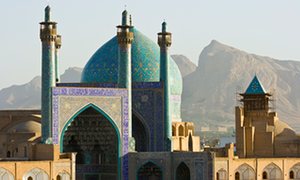
Isfahan should always be the last city on any travel itinerary in Iran. OK, I’m biased (it is my home town) but this truly is the jewel in the crown. Most of what we’ll see was built by Shah Abbas in the 17th century, when his capital was established here. The magnificent Naghshe Jahan Square, with its turquoise domes, and palace of Alighapou, positioned around an old polo field, are wondrous and you’ll want to see them again and again.
This is a living and working neighbourhood: Isfahanis still come to procure spices and jewellery in the old Gheisariyeh bazaar, and the surrounding passageways bustle with artisans making handicrafts. My favourite is the coppersmiths’ passage, where the cacophony of beating hammers is a centuries-old sound. Another joy is the ceiling of the Lotfollah mosque. Here, the design of the tiles creates the same sensation as watching a starry night, drawing you upwards as if falling into the sky. Not far away is the Jameh mosque, one of the oldest in the country, rebuilt in the 11th century. No colourful tiles here: the wonder is in the patterns and craftsmanship of the brickworks.
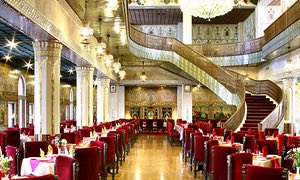
Finally, a major feature of Isfahan is the river, along the banks of which Isfahanis go to take the air. There are a number of old bridges here, from the plain-brick Si-o-se pol with its 33 arches, to the Khaju bridge with its decorative motifs and tiles, where the king would sit to enjoy the sound of water falling over specially designed steps. Nowadays, the river runs dry most of the year, but that hasn’t stopped Isfahanis continuing to use its banks in their leisure time.
Staying in the Abbasi hotel (doubles from £130 B&B) is a must. The old caravanserai has been converted into possibly the most beautiful hotel Iran has to offer. The quince-laden trees and the dome of the Chaharbagh seminary visible in the garden make this a magical end to your stay.
But only if you come!
Sound advice
Showing musical instruments being played is still banned on Iranian television but concerts are held regularly in Tehran. Visit Iran Music for details and catch a live gig.
State of the art
Housed in two renovated old houses in Tehran are Gallery O and Ab-anabar, both of which showcase cutting-edge art in what were once Tehran’s modern houses.
